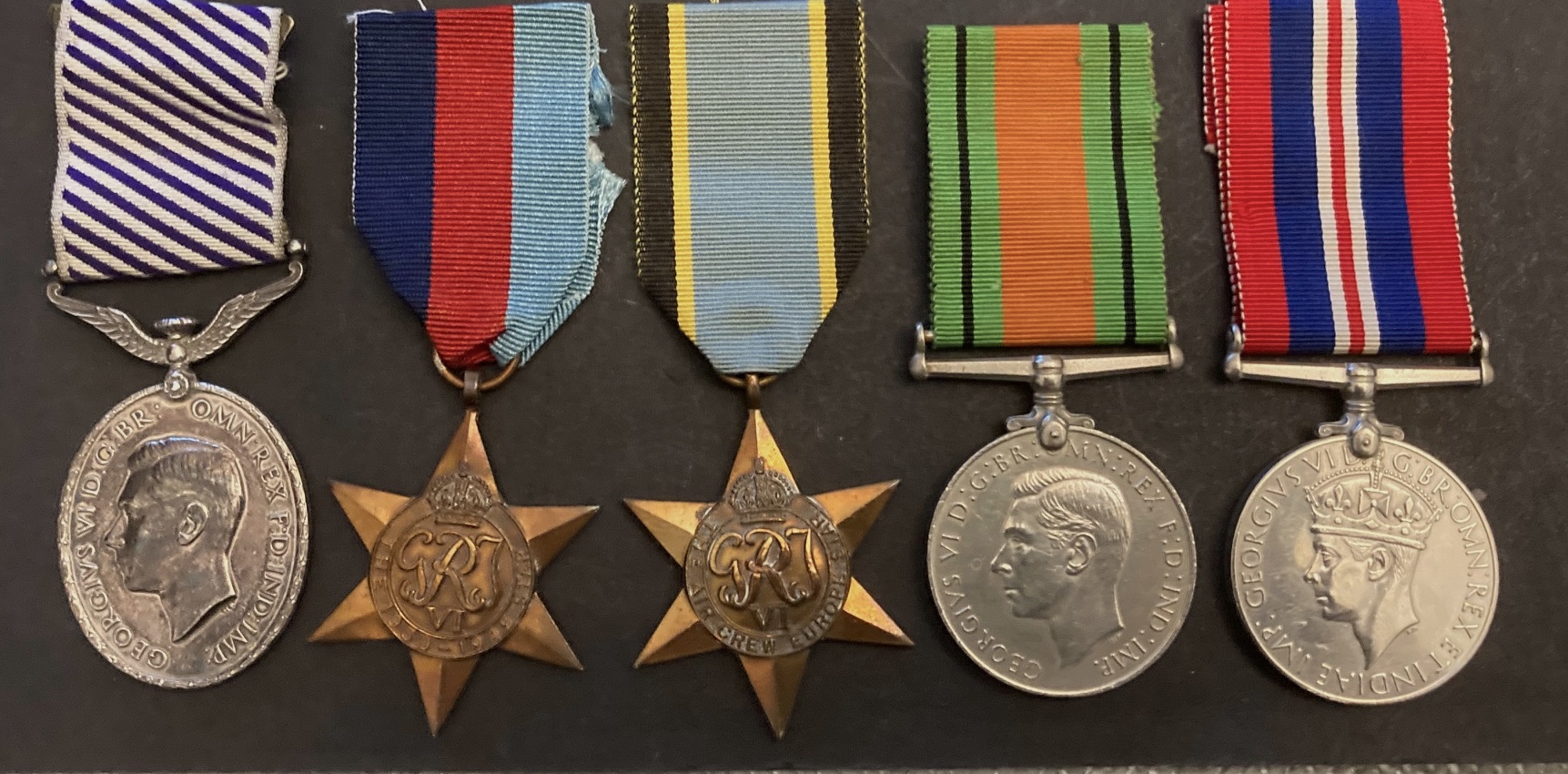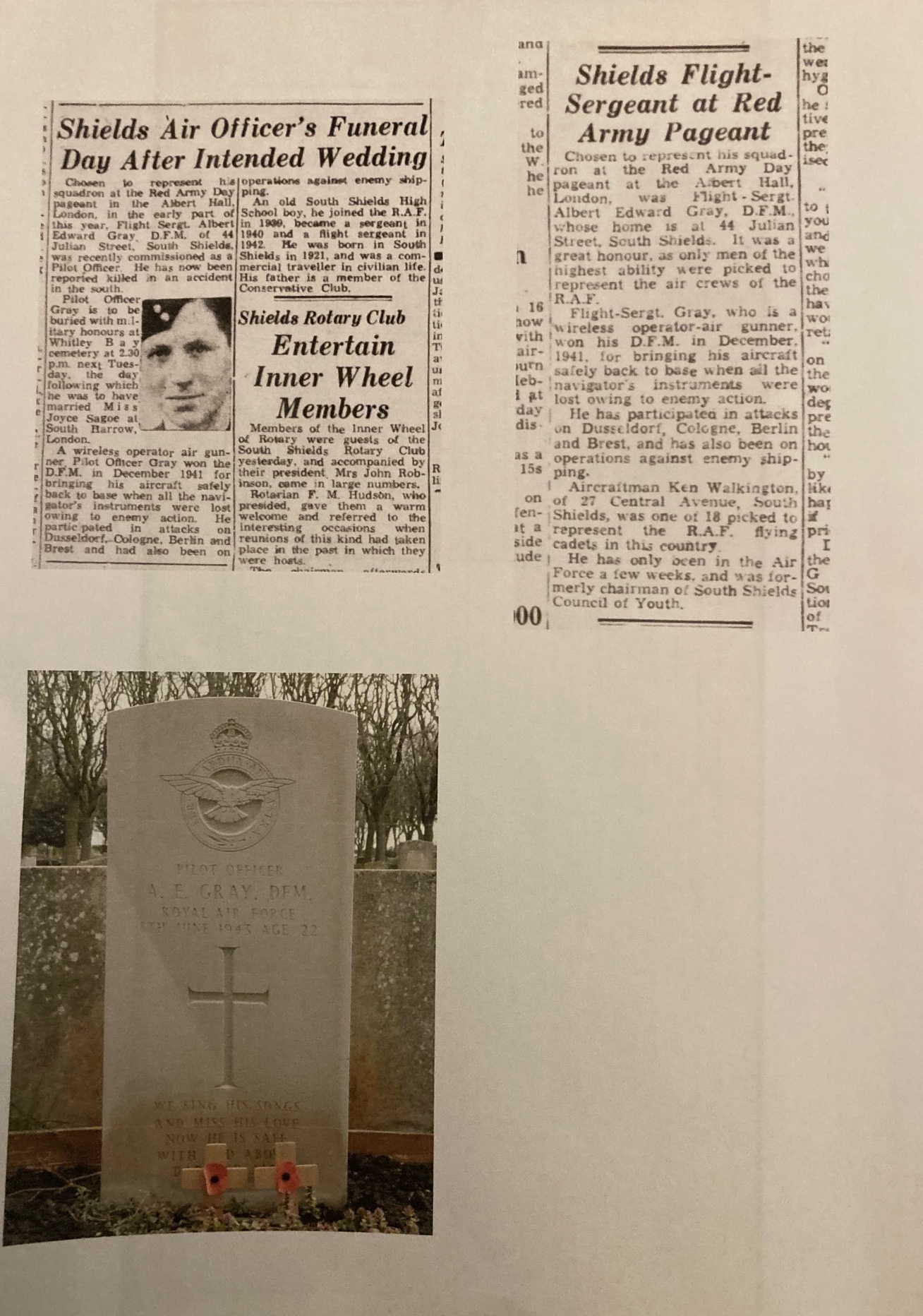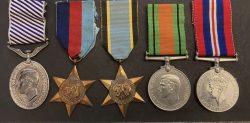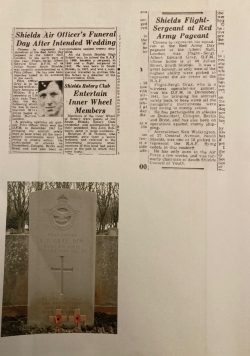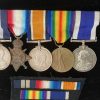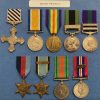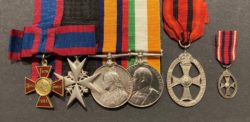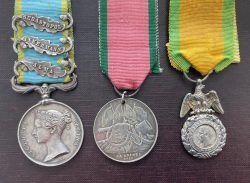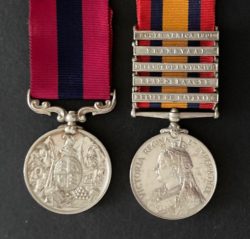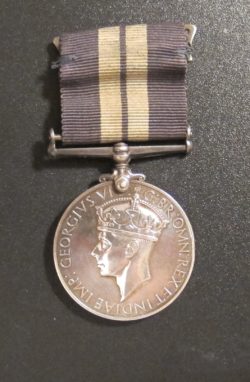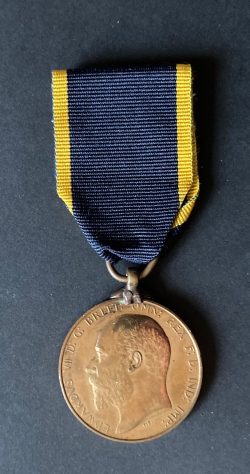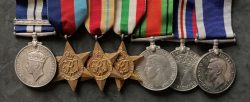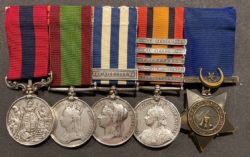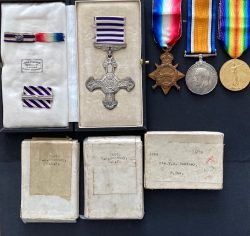Distinguished Flying medal , Air Crew Europe group , WO/AG later Pilot Officer with fine recommendation with 83 (Hampdens) included the sinking of a 7000 ton enemy vessel on the 5th op and credited with bringing the aircraft home by visual loop indicator when the navigator’s instruments were lost due to enemy action. Later served with 515 Special Duties (Defiants) the first Electronic countermeasures (ECM) squadron, jamming enemy radar installations from October 1942 as the only such squadron in the RAF at that time. Later killed in 1943 having completed a tour of 32 ops + 2 , 1000 bomber raids with 14 OTU and 33 ‘jamming’ ops with 515
£2,500.00
Out of stock
D.F.M. (GV1-Sgt. R.A.F.), on original ribbon & pin, 1939/45 Star, Air Crew Europe Star, Defence Medal, War Medal.
Pilot Officer Albert Edward Gray, 83 and 515 Squadrons Royal Air Force Volunteer Reserve,
L.G. 23/12/1941
Original recommendation states :-
Sergeant Gray has now completed 204.5 hours operational flying, a total of 32 sorties, including two to Berlin consecutively and a varietyn of flights such as Bremen, Hamm, Brunswick and Karlsruhe. On his fifth trip, he was Air Gunner in an aircraft which attacked and sank an enemy ship f 7,000 tons off the Fresian Isles. On another occasion during an attack on Brunswick, the Navigator’s instruments were lost due to enemy action. He brought the aircraft safely back to Base by means of the visual loop indicator. He has taken an active part in the training of the squadron’s Wireless Operator/Air Gunners and has at all times been an inspiration and help to them by his own outstanding personal example and his cheerful encouragement of others.’
At the end of his tour, (32 sorties) Gray returned to instruct at No 14 OTU at Cottesmore, which he joined on 10th November 1941. At that time the OTU had on its strength 49 Hampdens, 21 Ansons, 4 Oxfords, 2 Lysanders and 1 Tiger Moth. On 23rd Dececember 41 14 OTU’s operational record book listed two Bars to DFCs, one DFC and four DFMs recently awarded to 14 OTU officers and NCOs. Among them was Gray’s. He was promoted Flight-Sergeant on 1st April 1942, celebrated his 21st birthday three weeks later and, on 28th April, attended an investiture at Buckingham Palace to receive his DFM from the King.
On 30th/31st May 1942 he flew in one of 30 Hampdens from 14 OTU detailed to bomb Cologne. This was Harris’s first 1,000 Bomber Raid, designed to show his superiors, politicians, the press and the public what his new Command could achieve with sufficient resources. By combing crews from OTUs, Coastal Command and other sources, he finally assembled a force which just exceeded the magic number.
Of 14 OTU’s 30 crews briefed for the op, one attacked an alternative target, one aborted because of a faulty compass, one returned on one engine but crashed on landing killing both pilots, one collided with a Halifax over England on return and only the captain survived, and one was shot down by a nightfighter over Holland and again only the captain survived (as a prisoner of war).
Two nights later Gray flew on Harris’s second 1,000 bomber raid. This time for this attack on Essen
After an eight-month ‘rest’ at OTU, on 27th June 1942 he was posted back to operations with the Special Duties Flight (Defiant Flight) at RAF Northolt. In October 1942 this became 515 Squadron. Part of 11 Fighter Group, the Squadron was commanded by S/Ldr S R Thomas DFC AFC, an experienced night-fighter pilot. Equipped with Boulton-Paul Defiant Mark 2s, they were engaged in counter-measures against the German radar defences being the first Squadron tasked.
Working with the A&AEE at Boscombe Down and TRE at Malvern, their Defiants countered the German radar system, Freya, using equipment code-named Moonshine. Carried by Boulton Paul Defiants of the Special Duties Flight (later 515 Squadron), a single set retransmitted a portion of the Freya signal amplifying the apparent return. Eight aircraft with Moonshine could mimic a force of 100 bombers. Moonshine was first tested operationally on 6th Aug 1942. As the system required formation flying, it could only be used in daylight, where it could draw German fighters onto British fighters leaving another area relatively free for a British bombing raid. The second countermeasures system, Mandrel, which could be used at night, was a noise jammer which overwhelmed the signals from Freya. It was first used operationally by 515 Squadron on 5th/6th December 1942. Individual aircraft were sent to orbit fixed positions 50 miles (80 km) off the enemy coast. By using nine aircraft, a 200-mile (320 km) gap could be knocked into the German’s radar coverage, while further jammers were carried in the bomber stream to counter the inland Freya network.
The aircraft flew from RAF Tangmere, West Malling, Coltishall or Bradwell Bay. During Gray’s tour, they moved first (in late October 1942) to RAF Heston and then (in late May 1943) to RAF Hunsdon in Hertfordshire. He flew with various pilots, including the CO, but most often with F/Sgt Frederick Steel, aged 21, from Carlisle, who lived with his wife near Gateshead. Between 6th September 1942 and 5th June 1943, Gray flew 33 more ops, bringing his total to 67 operations.
Although they certainly would not have known it until the news broke next day, on 16th/17th May Steel and Gray were operating from West Malling in support of 617 Squadron’s Dams Raid. Their flight (2255-0035) would have jammed the radar between the first and third (reserve) waves who crossed the North Sea from Southwold to the Scheldt estuary.
On 6th June 1943 Gray was commissioned Pilot Officer. Gray and Steel died in a flying accident two days later. Gray’s records show that he died of his injuries. The entry for 8th June 1943 in 515 Squadron’s Operations Summary of Events Book reads:
All eight aircraft away at forward bases left their respective bases for Hunsdon during the morning. Seven of these arrived safely but F/Sgt F J A Steel (Pilot) and P/O A E Gray (Gunner) in aircraft AA435 left Tangmere at 1315 approx together with F/Lt A A Law in aircraft AA383. Owing to foggy weather conditions the two machines became separated. Aircraft AA435 crashed into a hill near Beachy Head and both the pilot and gunner were killed. An investigation into the accident has been ordered by Headquarters No 11 Group. Next of kin of both pilot and gunner were informed of the accident.
On 15th June 1943 P/O Albert Gray was buried in Whitley Bay (Hartley South) Cemetery. He had been due to marry the previous day.
With research detailing the recipient’s ops and copy newspaper cutting containing a photo of the recipient
